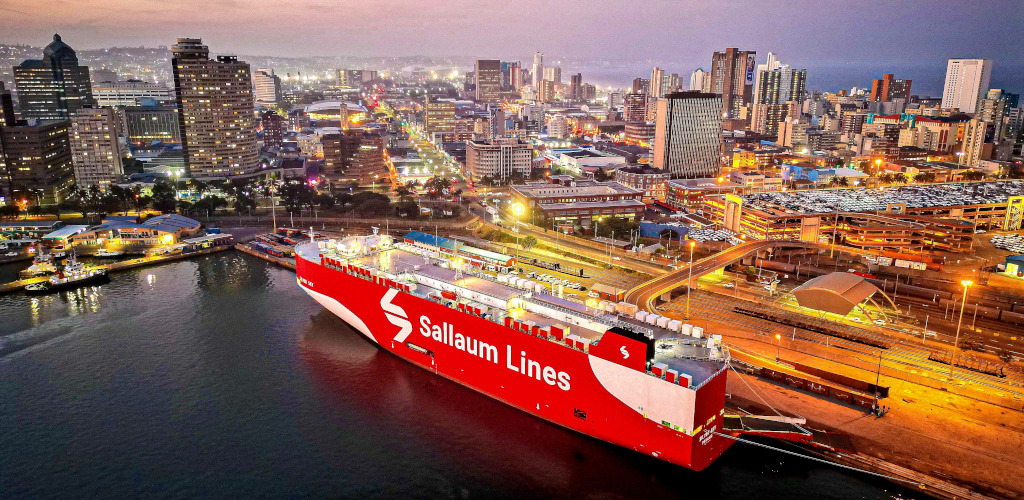High and Heavy Volumes Strong Amid Geopolitical Risks

By Carly Fields
Demand for PCTCs is expected to remain strong, driven by Chinese electric vehicle exports. But capacity constraints and geopolitical risks are generating uncertainty in the market. From Issue 2, 2024 of Breakbulk Magazine, industry leaders including DNV’s Hans Eivind Siewers and CEVA Logistics’ Emmanuel Cheremetinski assess the challenges.
(You can read this story in 5 minutes)
Global deep-sea car trade is set for a remarkable upswing, with an estimated 17 percent growth to 23.7 million cars in 2023, surpassing the pre-Covid record set in 2018. Clarksons’ David Whittaker attributes this surge to resurgent Chinese exports and increased production in key regions, marking a recovery from component shortages in the preceding years.
However, a looming challenge is the industry’s tight fleet, with a minimal 2 percent expansion since 2019, coupled with existing pure car and truck carriers, or PCTCs, being locked into long-term fixtures. As the sector anticipates significant growth in the coming years, uncertainties persist, ranging from the impact of geopolitical issues in the Middle East to the evolving landscape of environmental regulations, setting the stage for a complex future for the PCTC industry.
Clarksons’ Shipping Research Manager Whittaker, writing in the broker’s Car Carrier Trade & Transport 2023 report, said surging China-Europe volumes mean that ‘car-mile’ trade is set to grow by 19 percent this year. Of note, “high and heavy” volumes were said to be strong, evidenced by the “growing share of trade accounted for by generally larger and heavier EVs and hybrids.” This was up 29 percent in 2023, up from 9 percent in 2019. This has further “turbocharged” vessel demand, Whittaker said.
But the extremely tight fleet is causing complications. Data published in December 2023 from Clarksons counted 80 vessels of 677,000 car equivalent units (ceu) ordered in 2023 - a new annual record. The orderbook at that point stood at circa 37 percent of fleet capacity.
But “further ahead… there is more uncertainty; fleet growth is projected to pick up to ~8 percent per annum in 2024-25, while it is unclear to what extent car trade growth might ‘cool off’ once pent-up demand is worked through, especially given consumer pressures and downside risks,” Whittaker said. Clarksons’ base case is for 5 percent growth in 2024 and 3 percent in 2025.
Hans Eivind Siewers, segment director passenger ships and ro-ro at DNV, said that even though the PCTC order peak has most probably passed, there are many signs that the market will continue to be strong in 2024/25. “We have a very high demand, in particular driven by the fast-growing Chinese EV industry, combined with a decade of low ordering,” he said to Breakbulk. This increased demand is countered by the current geopolitical issues in the Middle East, with many operators avoiding the Red Sea and taking the longer route around Africa instead, which artificially reduces capacity.
‘Game Changer’
 Speaking to Breakbulk, Dan Nash, head of container, ro-ro and ro-pax at maritime software specialist Veson Nautical, said that net fleet growth of 6-7 percent is expected this year, followed by 11 percent supply growth in 2025 “which will be the real game changer, resulting in freight rates, charter rates, and asset values correcting to long term historical averages thereafter, assuming demand holds from China/Asia – the main source of export demand in this sector.”
Speaking to Breakbulk, Dan Nash, head of container, ro-ro and ro-pax at maritime software specialist Veson Nautical, said that net fleet growth of 6-7 percent is expected this year, followed by 11 percent supply growth in 2025 “which will be the real game changer, resulting in freight rates, charter rates, and asset values correcting to long term historical averages thereafter, assuming demand holds from China/Asia – the main source of export demand in this sector.”
He added that demand was comfortably outpacing supply by circa 10 percent before the disruption in the Red Sea, which has added 12 days of voyage time for most car carriers now diverting via Africa instead of transiting the Suez.
“The supply-demand imbalance is set to widen during the first half of this year if instability in the Red Sea continues into next quarter, from reduced ship call frequency lowering car inventories, leading to increased pent-up demand for ocean transportation, firming rates and values,” Nash said.
Sustainability data specialist Esgian noted that the Suez Canal was empty of roll-on, roll-off ships on Jan. 23, something they described as “unique considering this strategically important area in the East/West trading corridor.” In 2023, there were 900 Suez Canal voyages - 500 eastbound and 400 westbound – of ships moving cars and other rolling stock, according to Esgian’s data.
“We see that the ro-ro activity in the Suez Canal is down 70 percent so far in January vs. monthly average 2021-2023, whereas it’s getting crowded outside the Cape which is up 133 percent in the same period. Bad for global trade and bad for the environment, but how long will it last?” asked Esgian.
Back to the Future
Stian Omli, Esgian’s senior vice president shipping, said to Breakbulk that to gauge future impacts, one must start by looking back to the factors that have contributed to the current strong PCTC market. “It’s a complex affair,” he said. “One can argue it all started with Covid-19 and the effects of the pandemic. The automotive industry experienced significant supply chain disruptions as the shipping side had an issue with a lack of labor both on ship and on shore. This created somewhat of a vacuum in the early days of Covid.
“With interest rates plummeting and ‘most’ people still retaining their income, saving rates went significantly up as spending was restricted. As such, the demand for new cars increased a lot during the 2021-2022 period but supply was restricted.”
Omli said that the order backlog for cars peaked in the middle of 2022 in Europe but has fallen significantly since and is now back at pre-Covid levels, if not lower. “When you throw China’s EV exports into the mix (longer sailing distance), port congestion in several key areas (notably Australia and Mexico), and little new capacity coming into the market it has all pushed freight rates up.”
He sees the PCTC market heading for a soft landing, based on four assumptions: up to 40 new buildings will enter the market in 2024; the Red Sea situation is resolved; Chinese EV exports do not continue to grow exponentially; and the container option continues to be a cost-effective alternative to PCTCs.
 Emmanuel Cheremetinski, global finished vehicle logistics leader at CEVA Logistics, added to the positive PCTC voices. “While the automotive manufacturing market looks to remain flattish in 2024, it’s still a strong market, and car makers appear ready to continue producing and moving vehicles from global production sites to end markets for sale and for stocking,” he said to Breakbulk.
Emmanuel Cheremetinski, global finished vehicle logistics leader at CEVA Logistics, added to the positive PCTC voices. “While the automotive manufacturing market looks to remain flattish in 2024, it’s still a strong market, and car makers appear ready to continue producing and moving vehicles from global production sites to end markets for sale and for stocking,” he said to Breakbulk.
While high inflation rates escalating raw material prices and the semiconductor shortage in 2022 and 2023 combined to weigh down and delay the automotive sector’s recovery from the pandemic, manufacturers are now looking to take advantage of every opportunity in the current market conditions to transport finished vehicles to end markets, he said.
“As a result, we expect that the next two to three years will remain very challenging in the car carrier market, both in deep-sea and shortsea applications,” Cheremetinski said. “Capacity is constrained, and while there are new vessels coming online this year and next year, global demand remains strong, so capacity in the market will remain tight.”
In response to these market needs, CEVA is deploying four new 7,000-car, deep-sea vessels in 2024. “We expect to be able to transport approximately 140,000 vehicles per year thanks to the new vessels.”
Future Challenges
Esgian’s Omli counts the challenges on the horizon. Firstly, new players coming into the market, notably Chinese, will alter market dynamics. Second, containers will continue to be an alternative option for carriage. Third, customer demand may stagnate. And fourth, increasing environmental regulations will take their toll.
Omli is particularly concerned about the last point. Tightening emission regulations will have an effect, he said. “Take EU ETS for instance - it’s not only a cost (carbon credits), but since the supply of such credits will go down, shipping lines are forced to reduce their CO2 emissions as a ‘license to operate’.”
 DNV’s Siewers agreed that environmental regulations will result in some capacity decrease due to speed reduction and possible early retirements. “As with the rest of the shipping industry, decarbonization is one of the main challenges,” he said. “And it is fascinating to observe that this is the first segment where almost all orders are with alternative fuels.” Most PCTC orders are for dual fuel engines, harnessing LNG, but there are some orders for dual fuel with methanol, and ammonia-ready ships.
DNV’s Siewers agreed that environmental regulations will result in some capacity decrease due to speed reduction and possible early retirements. “As with the rest of the shipping industry, decarbonization is one of the main challenges,” he said. “And it is fascinating to observe that this is the first segment where almost all orders are with alternative fuels.” Most PCTC orders are for dual fuel engines, harnessing LNG, but there are some orders for dual fuel with methanol, and ammonia-ready ships.
Siewers added another challenge to the outlook for PCTCs: re-occurring fires on ro-ro decks. “We have cases every year and even total losses. This is something that all operators have to have an extremely high focus on.”
DNV also sees an increased tendency towards larger capacity ships, capturing economies of scale. In December 2023, a series of PCTCs with a record capacity of 10,800 ceu capacity were ordered in China. “We think the drive for cost efficiency per transported unit and decarbonization drive will continue to push in this direction,” he said.
Also, energy efficiency will be an increasingly important part of the mix, due to the expected high price of low carbon fuels, Siewers said.
Electric Avenue
CEVA Logistics’ Cheremetinski sees the rapid growth of EVs as a trend to watch in finished vehicle logistics in the near term. “In general, these vehicles are heavier, and their unique nature due to the lithium batteries requires unique handling all along their supply chain and transport.” Added to which, the size of vehicles continues to change. “This trend will likely continue, already leading many transporters, including CEVA, to move to a new pricing model that is based on cubic meters, and not a ‘per vehicle’ model.”
The changing global economic situation and related tariffs could also play a role in reshaping automotive manufacturing and the transport of finished vehicles, Cheremetinski continued. “For example, a decision is expected in 2024 related to the import of vehicles into Europe. An increase in any import taxes could create a nearshoring effect for the production of vehicles, with secondary effects on how those vehicles are then transported to end markets — more land-based than via ocean vessels.”
Protectionist threats will not be the only driving force for nearshoring. “As the transition towards EVs will be long, competition on market share and time to market will remain fierce, while dragging on OEMs’ profitability. Nearshoring will be one answer to such a conundrum. Therefore, the PCTC market will need to adapt, all the more as smaller vessels tend to not be the most cost efficient,” Cheremetinski said.
Likewise, changes in global trade dynamics, such as shifts in manufacturing locations or trade policies, could have a significant impact on the car carrier vessel market. “Monitoring geopolitical developments and trade agreements can help identify potential trends and opportunities in this market,” Cheremetinski said.
Finally, environmental concerns and regulations are driving the adoption of greener shipping practices. This includes the use of cleaner fuels, such as liquefied natural gas or alternative fuels, in PCTC vessels. Therefore, keeping an eye on developments in sustainable shipping will be important for the industry.
Breakbulk Europe 2024 is taking place on 21-23 May at Rotterdam Ahoy.
TOP PHOTO: Sallaum Lines’ Silver Sky vessel carrier. CREDIT: Esgian
